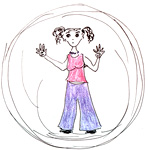
May 12, 2009
more pakour
Posted by dogpossum on May 12, 2009 11:59 AM in the category lindy hop and other dances and yoga | Comments (1)
Watching this (occasionally annoying) video about pakour/freerunning, I was struck by the similarities between these jumps and lindy hop.
I'm most interested in the landings, and in the way momentum or velocity are managed. I don't know a whole lot about the science of this stuff, so my comments are purely ill-informed conjecture.
When this guy lands, he tends to land with his feet shoulder width apart and his knees bent. This makes for stable landings - this distance between your feet is optimal for a nice, stable landing. The bent knees are also very stable - straight legs are unsteady and tend to lift your centre. When your centre is lower, you have more stability. But you don't want to be too low - it's harder to recover from a very low pose. The bent knees function a bit like springs or suspension on a car - they absorb the energy of your fall, but they also allow you to store the energy to use it again for another movement. Landing with straight legs and close together feet makes for a) jarring and b) instability.
These are all things that are really important in lindy hop. Because lindy (in the old school sense) is fast, and, essentially, like playing a basketball game within a two meter square space, you need to be able to move quickly, to make quick turns, to not lose your momentum. This makes bent knees and shoulder-width apart feet very useful. Old school lindy hoppers like Frankie Manning, who was known for his air steps, would also lean forward, bending at the hips and putting their hips back. This added 'hinge' gives greater stability and also adds another layer of 'stored energy'. It also requires your activating the layers of muscles in your torso that keep you stable and also allow you to respond quickly with turns and twists.
Here, have a look a this iconic footage (Manning is in the overalls):
I'm interested in the way these practical mechanics have been translated into bodily aesthetics. The straight leg and pointed toe are classic markers of ballet and of feminine beauty - the longer-seeming leg, the tinier foot.
It's also interesting to watch the first clip and see how this guy uses the energy from a drop or jump to move immediately into another jump (so it looks like he's springing up), or how he translates that energy into a roll. How are his feet positioned then?
Of course, all this contrasts really nicely with yoga, where you move between poses very slowly - you don't bleed off momentum with bounces or other movements. Your muscles have to be strong enough to move you through poses (and to hold you in them) without losing energy. And you hold poses for a longer time.
NB I think the reason I'm so aware of this stuff is that quite a few leads have a tendency to stop the follow during a faster dance. When you're moving at speed, it's less work to maintain the momentum than to stop and have to start again. This means that sequences of moves which use larger movements are easier on the follow than a combination of (for example) swing outs and (to be ridiculous) body rolls. It's also a reason why it's important to not stop your swingout half way through (on '4' or so); you want to keep the movement happening.





Comments
Posted by: jac at May 14, 2009 12:27 AM
How awesome is that lindy hop clip! I'm exhausted just watching it. So impressive.
Posted by: jac at May 14, 2009 12:27 AM
Post a comment